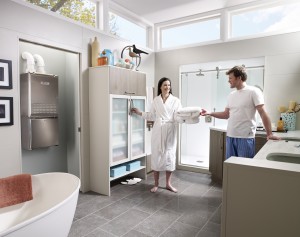Why you shouldn’t always believe everything you hear about instant hot water and other tankless myths.

You’ve seen it on the television show, MythBusters, and you’ve even heard it from your own mother: Everything you see and hear doesn’t always necessarily reflect reality. Below we’ve BUSTED some common myths on instant hot water heaters.
1.On-demand-type (tankless) water heaters make sense only in homes where water fixtures are close together: BUSTED
Explanation: Every home has multiple fixtures. The reality is that we don’t use all our fixtures all the time, and not all water-related tasks require hot water. The ones we worry about most are our showerheads because of the amount of hot water they use in a comparatively small time frame; i.e., first thing in the morning. But sized properly, a tankless system can meet all of a household’s hot-water needs, including from multiple showers that run simultaneously, as everyone gets ready for the day.
If you have body sprays or multiple shower heads in your master bath, you’re probably especially concerned about hot-water availability. Here, you might want to consider a dedicated tankless heater, sized to provide a continuous flow of water at the desired temperature and never run out. That’s not the case with a tank-type water heater: Once the tank is emptied, you’re stuck waiting for it to replenish itself.
2. Tankless is best used as a point of use device in a large home: BUSTED
Explanation: Point-of-use is more commonly used in nursing homes or hospitals—places that need immediate access to hot water for washing or bathing someone.
As already noted, if sized properly, tankless systems can meet all the hot-water needs of entire households. Tankless units activate instantly when hot-water demand is detected (someone turns on a shower), but deactivate as soon as that demand is met, thus saving energy by not continually reheating water throughout the day when no demand exists.
But, unlike a point-of-use heater, tankless technology does not — by itself — provide “instant” hot water at the faucet, shower or appliance. The hot water must still travel through piping from the water heater to the outlet.
To eliminate that wait, a hot-water recirculation system should be installed, keeping hot water close to the outlet, minimizing the wait and, therefore, the waste of unused potable water down the drain. Newer, state-of-the-art tankless systems — including NRCP98-DV and the NRCP1112-DV, launching this October – use an internal pump to keep warm water circulating only when it is needed, rather than round-the-clock. Once again, that saves energy without lessening comfort or convenience.
3. Tankless is better for irregular usage: BUSTED
Explanation: That’s true. But, remember, irregular usage is the norm, not the exception. What household uses a constant amount of hot water around the clock?
That’s why a tankless water heater makes sense for all kinds of residential applications. It provides all the hot water that is required during periods of intensive use — showers in the morning, baths in the evening, clothes washing during the day. The rest of the time it sits idle, saving energy that a continuously operating storage-tank water heater wastes because its pilot light always on.
Not only does tankless save energy, it also saves space, adding value to a smaller home or apartment. Smaller tankless units are also price-competitive in replacement situations because they do not require a new (larger) gas line to be installed.
The bottom line: Everyone’s hot-water usage is irregular, which is why tankless provides the best of all worlds: a continuous and abundant supply of hot water that never runs out, with minimal energy consumption, and less wear and tear on the unit for a longer life cycle and an eventual payback.
For more information on tankless water heating, visit Noritz.com
